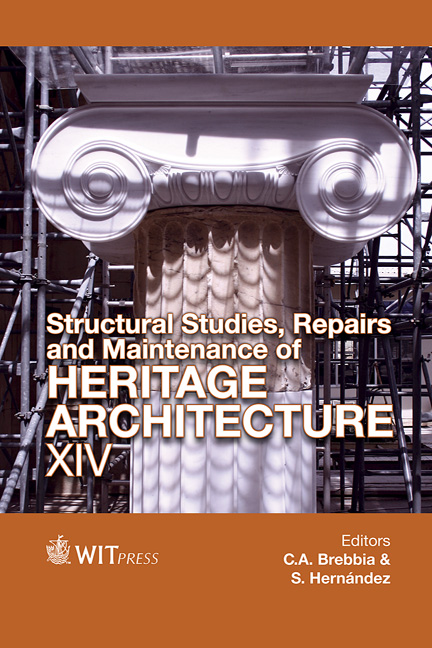Assessment By Non-destructive Testing Of New Coating Mortars For Retrofitting The Architectural Heritage
Price
Free (open access)
Transaction
Volume
153
Pages
10
Page Range
357 - 366
Published
2015
Size
686 kb
Paper DOI
10.2495/STR150301
Copyright
WIT Press
Author(s)
I. Palomar, G. Barluenga, J. Puentes
Abstract
Repairing or replacing the traditional coating lime-based mortars is a common measurement to retrofit building facades. The use of appropriate techniques and materials according to the originals is essential to ensure architectural values and to preserve the Architectural Heritage. Consequently, it is necessary to investigate the microstructure and properties of both traditional and today’s mortars by proper characterization. Non-destructive testing techniques (NDT) are always preferred because they can be tuned in the laboratory and also applied to evaluate on-site performance. In this paper, the assessment of lime-cement repair mortars’ microstructure and performance is carried out using NDT by ultrasonic pulses (US). Ten lime-cement mortars were designed using: hydrated lime; white cement; gap-graded siliceous aggregate (2–3 mm); three lightweight aggregates, expanded clay, perlite and vermiculite; two types of short fibres, cellulose and polypropylene. The samples were evaluated with compression and shear US waves (P- and S- respectively). Transmission times (UPV), compressive modulus (M), shear modulus (G), dynamic Young modulus (E), bulk modulus (K) and Poisson’s ratio (ν) were obtained. The raw US signals were also analysed by Hilbert transformation (HT) and Fast Fourier transformation (FFT). HT facilitated P- and S-wave transmission time measurements while FFT simplified the evaluation of US attenuation. Then, bulk density, open porosity, capillary absorption, thermal conductivity, acoustic absorption and compressive and flexural strength of samples were compared to the US parameters. NDT by ultrasonic pulses showed very good correlations with hardened properties and demonstrated to be a useful tool for predicting the physical and mechanical performance of lime-cement repair mortars.
Keywords
lime-cement mortar, NDT, ultrasonics, physical properties




